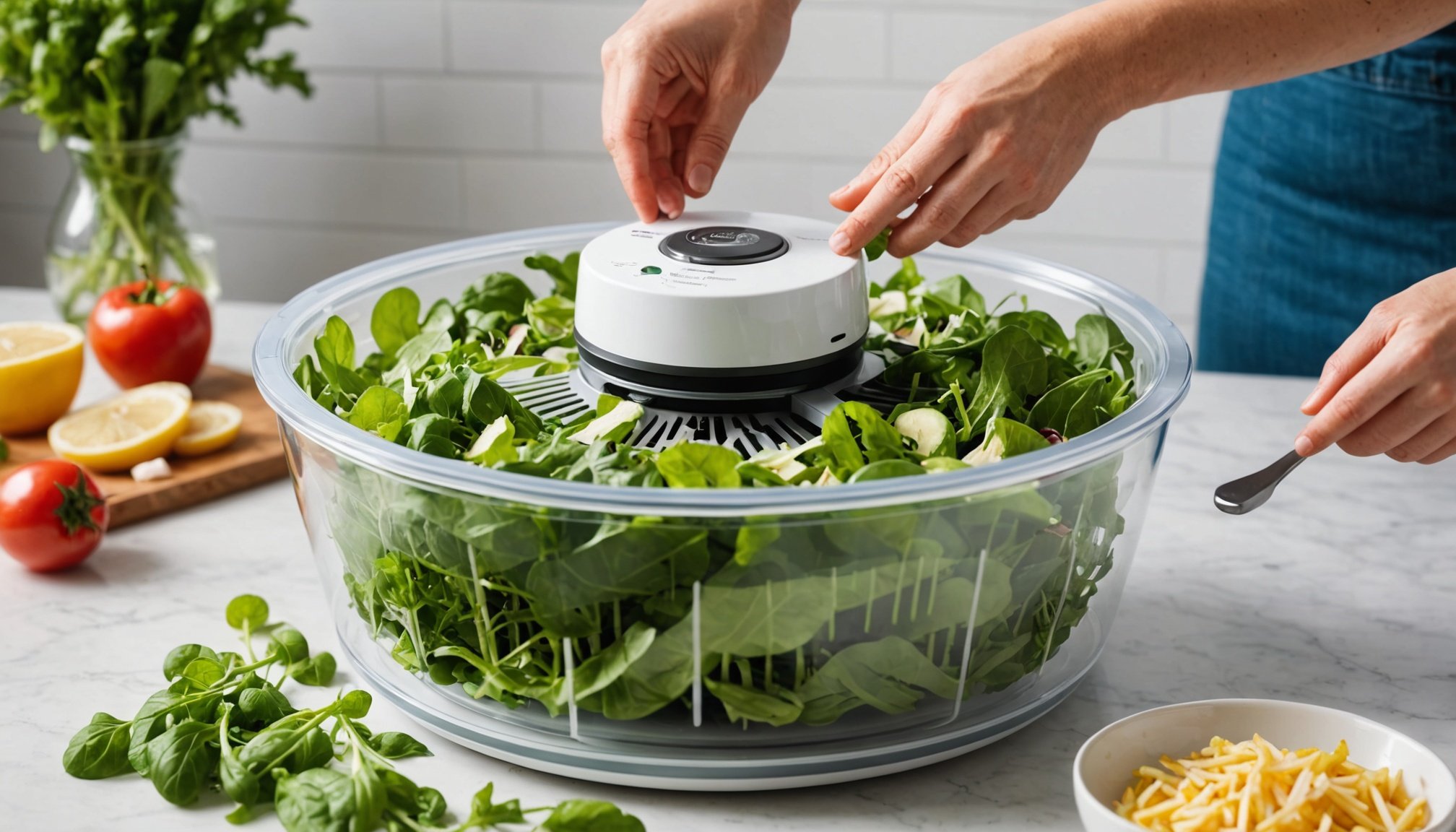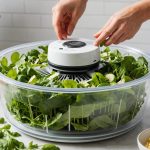A salad spinner might seem like a simple kitchen tool, but choosing the right one is essential for preserving the quality of delicate greens. Heavy-duty spinners can bruise or damage tender leaves, which hampers flavor and nutrition. This guide walks you through selecting a gentle salad spinner tailored for your culinary needs. You’ll discover effective features, materials, and usage tips that ensure your greens remain fresh, crisp, and vibrant. Your salads deserve the best—let’s find the perfect spinner to keep your salads delicious and intact.
Understanding Delicate Greens
Delicate greens are a staple in many salads, offering a light and refreshing base for various dishes. These greens are known for their tender leaves and mild flavours, making them a favourite among salad enthusiasts. When preparing salads, choosing the right types of greens is crucial to achieving the desired taste and texture.
In parallel : Unlock the Secret to Effortless Fish Scaling: Your Guide to Selecting the Best Quality Scaler
Common Types of Delicate Greens
Several types of greens fall under the category of delicate greens. Some of the most popular include:
- Arugula: Known for its peppery taste, arugula adds a unique zing to salads.
- Butterhead Lettuce: With its soft and buttery leaves, this lettuce is perfect for creating a smooth texture.
- Mâche: Also known as lamb's lettuce, mâche offers a nutty flavour and velvety leaves.
- Baby Spinach: Tender and slightly sweet, baby spinach is versatile and can be used in various salad combinations.
Importance of Proper Handling
Maintaining the freshness of delicate greens is essential to preserve their flavour and nutritional value. Proper handling involves gentle washing and drying, as well as storing them in a cool environment. Using a salad spinner can help remove excess moisture without damaging the leaves. By taking these steps, you ensure that your greens remain crisp and vibrant, enhancing the overall quality of your salad.
Also to discover : Top 5 Sturdy Kitchen Table Surfaces for High-Traffic Family Homes
Key Features of a Gentle Salad Spinner
When it comes to preserving the integrity of delicate greens, selecting a salad spinner with the right features is paramount. A crucial aspect is the gentle spinning speed. This ensures that the tender leaves are not bruised or torn, maintaining their texture and appearance. Salad spinners with adjustable speeds allow users to customize the spin, catering to the needs of various greens.
Design considerations play a significant role in minimizing damage. The shape of the bowl and the design of the basket are essential. A rounded bowl with smooth edges reduces friction, while a well-ventilated basket ensures even drying without exerting excessive pressure on the leaves.
Materials are another critical factor. High-quality, food-safe plastics or stainless steel are recommended for both safety and effectiveness. These materials are durable, ensuring the spinner lasts while being gentle enough to handle delicate greens with care. By focusing on these key features, you can ensure that your salad spinner meets the needs of your culinary creations.
Top Salad Spinner Recommendations
When selecting the best salad spinners, it is essential to consider various factors such as price, features, and user feedback. This section will explore top-rated models, offering insights into their performance and suitability for delicate greens.
High-End Options
For those seeking premium quality, high-end salad spinners offer advanced features and durability. These models are often constructed with stainless steel or high-quality plastics, ensuring longevity and effective performance. They typically include adjustable spinning speeds and ergonomic designs, making them ideal for handling delicate greens with care. User reviews often highlight their quiet operation and efficient drying capabilities, making them a favourite among culinary enthusiasts.
Budget-Friendly Choices
Budget-friendly salad spinners provide a cost-effective solution without compromising on essential features. These models often come with basic spinning mechanisms that are sufficient for everyday use. While they may lack the sophisticated features of high-end options, they still offer reliable performance for drying greens. User reviews frequently commend their ease of use and compact designs, which are perfect for smaller kitchens.
Unique Features to Consider
When comparing salad spinners, certain unique features can enhance their usability. Look for models with a non-slip base to ensure stability during operation. Some spinners also feature a collapsible design, allowing for easy storage. Additionally, models with integrated braking systems can help control the spinning process, preventing damage to delicate greens. User reviews often highlight these features as valuable additions that improve the overall experience.
Tips for Using a Salad Spinner Effectively
Using a salad spinner correctly can significantly enhance the quality of your salads by ensuring your delicate greens remain fresh and crisp. Here are some salad spinner tips to help you achieve the best results:
Proper Loading Techniques
When loading your salad spinner, it is essential to avoid overcrowding. Place the greens loosely in the basket to ensure even spinning and prevent damage. Overloading can cause the leaves to bruise or tear, compromising their texture and appearance. By giving the greens ample space, you allow the spinner to work effectively without exerting excessive pressure.
Recommended Spinning Times
Different types of greens require varying spinning times to achieve optimal dryness. For more delicate greens like arugula or butterhead lettuce, a gentle spin for about 10 to 15 seconds is ideal. This minimizes the risk of bruising while effectively removing excess water. Hardier greens, such as kale or romaine, can withstand a slightly longer spin, around 20 to 30 seconds, to ensure thorough drying.
Tips for Drying and Storing Greens Post-Spin
After spinning, gently pat the greens with a clean kitchen towel to remove any remaining moisture. Proper storage is crucial for maintaining freshness. Transfer the dried greens to an airtight container lined with a paper towel to absorb residual moisture. Store them in the refrigerator to keep them crisp and ready for use. By following these usage instructions, you can extend the shelf life of your greens and enhance the flavour of your salads.
Maintenance and Care for Your Salad Spinner
Proper salad spinner maintenance is essential to ensure its longevity and optimal performance. Regular cleaning and careful handling can prevent damage and prolong the life of your kitchen tool.
Recommended Cleaning Practices for Longevity
To maintain your salad spinner, it is crucial to clean it thoroughly after each use. Begin by disassembling the spinner, separating the bowl, basket, and lid. Wash each part with warm, soapy water, using a soft sponge to avoid scratching. Rinse thoroughly to remove any soap residue. If your spinner is dishwasher-safe, you can place the components on the top rack for convenience. Ensure all parts are completely dry before reassembling to prevent mould or mildew growth.
How to Disassemble and Reassemble Your Spinner
Understanding how to properly disassemble and reassemble your salad spinner is vital for effective cleaning. Most spinners have a detachable lid that can be easily removed by twisting or unlocking a latch. Once the lid is off, the basket and bowl can be separated. Reassembling involves placing the basket back into the bowl and securing the lid. Always refer to the manufacturer's instructions for specific guidance, as designs may vary.
Troubleshooting Common Issues with Salad Spinners
Occasionally, salad spinners may encounter issues such as a jammed mechanism or uneven spinning. If the spinner jams, check for any debris lodged in the gears or basket. Clean the area thoroughly and ensure all components are aligned correctly. For uneven spinning, ensure the basket is not overloaded or imbalanced. Adjust the contents and try spinning again. Regular maintenance and proper use can prevent these common problems, ensuring your salad spinner remains a reliable kitchen tool.
Addressing Common Concerns
When it comes to using a salad spinner, many users have concerns about effectively handling delicate greens without causing damage. Understanding these common issues and implementing best practices can help alleviate these worries.
One frequent concern is the potential for bruising or tearing the tender leaves during the spinning process. To prevent this, it's crucial to use a gentle spinning speed and avoid overcrowding the basket. This ensures that each leaf has enough space to move without excessive pressure. Additionally, selecting a salad spinner with adjustable speeds can provide more control, allowing you to cater to the specific needs of different greens.
Users often have FAQs about salad spinners, especially regarding their effectiveness and maintenance. A common question is whether a salad spinner can handle all types of greens. While most spinners are versatile, it's essential to adjust the spinning time and speed based on the fragility of the greens. Another frequent inquiry is about cleaning and storage. Regular cleaning with warm, soapy water and ensuring all parts are completely dry before storage can prevent mould and prolong the spinner's lifespan.
By addressing these concerns and following best practices, you can maintain the quality of your delicate greens and enhance your salad-making experience.











